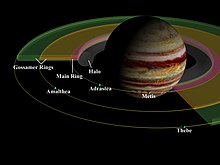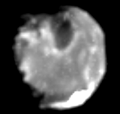Amalthea (moon)
| Amalthea | |
|---|---|

|
|
| Black-and-white image of the Galileo space probe , 1999. Ida Facula and Lyctos Facula are on the top left and bottom left. | |
| Central body | Jupiter |
| Properties of the orbit | |
| Major semi-axis | 181,400 km |
| Periapsis | 180,800 km |
| Apoapsis | 182,000 km |
| eccentricity | 0.0032 |
| Orbit inclination | 0.380 ° |
| Orbital time | 0.498 d |
| Mean orbital velocity | 26.49 km / s |
| Physical Properties | |
| Albedo | 0.090 |
| Apparent brightness | 14.1 mag |
| Medium diameter | 167 km |
| Dimensions | 2.07 x 10 18 kg |
| Medium density | 0.85 g / cm 3 |
| Sidereal rotation | 0.498 days |
| Axis inclination | 0 ° |
| Acceleration of gravity on the surface | 0.02 m / s 2 |
| Escape speed | 57.5 m / s |
| discovery | |
| Explorer | |
| Date of discovery | September 9, 1892 |
| Remarks | Simply bound rotation |
Amalthea (also Jupiter V ) is one of the inner moons of the planet Jupiter .
discovery
The moon was discovered on September 9, 1892 by the astronomer Edward E. Barnard at the 91 cm refractor of the Lick Observatory during a systematic search for other Jupiter moons. It was the fifth moon of Jupiter to be discovered after the first observation of the four Galilean moons in 1610. It was also the last moon to be discovered through telescopic visual observations . All later finds from the moon were made on the basis of photographic recordings.
It was named after the nymph Amalthea from Greek mythology , who Zeus raised with goat milk. The name "Amalthea", which goes back to a suggestion by the French astronomer Camille Flammarion , was only officially assigned by the International Astronomical Union (IAU) in 1975, although it had been in unofficial use for decades. Before 1975, the moon was mostly referred to simply as "Jupiter V".
Structure and physical data
Amalthea is a very irregularly shaped body and has roughly the shape of an ellipsoid with an extension of 270 km × 168 km × 150 km, with the longitudinal axis pointing towards Jupiter. Therefore, the moon must rotate around the giant planet in its present orbit long enough for its tidal forces to bring it into the position of lowest energy. The density is very low at 0.86 g / cm 3 ; this speaks for a porous structure made of water ice . It is possible that it is a "run-up" object that either comes from the outer Jupiter system or originated at a great distance from the Sun and was captured by Jupiter's attraction.
Amalthea has a very dark, deep red colored surface with an albedo of 0.09; that is, only 9% of incident sunlight is reflected. The red color may be due to deposits of sulfur that was hurled into space by the moon Io during volcanic eruptions. In addition, bright greenish patterns are visible, the origin of which is still unknown.
The surface is badly cratered. Some of the impact craters are very large compared to Amalthea's size. The largest Pan crater has a diameter of 100 km and is 8 km deep. Gaea crater has a diameter of 90 km and is believed to be 16 km deep. Two mountain ranges, Mons Lyctas and Mons Ida , rise about 20 km.
Amalthea rotates around its own axis in 11 hours and 57 minutes and, like the Earth's moon and the other inner moons of Jupiter, shows a bound rotation .
The apparent brightness is 14.1 m , so that Amalthea appears as a faint object and is difficult to see from Earth because of the brightness of nearby Jupiter.
Like Io, Amalthea gives off more heat than the body receives from the sun . This could be due to electrical currents induced by Jupiter's magnetic field as the moons move .
gallery
Photo taken by Galileo in 2000
Web links
- IAUC 2846: Satellites of Jupiter October 7, 1975 (designation)
- Who is Amalthea? from the alpha-Centauri television series(approx. 15 minutes). First broadcast on May 11, 2003.
- More recent findings on the density and texture of Amalthea
- Jupiter's Moon Had A Far-Flung Past
Remarks
- ↑ a b c d Amalthea , in: Lexikon der Astronomie , Herder, Freiburg im Breisgau 1989, Vol. 1, ISBN 3-451-21491-1 , p. 23.
| before | Jupiter moons | after that |
| Callisto | Amalthea |
Himalia |




